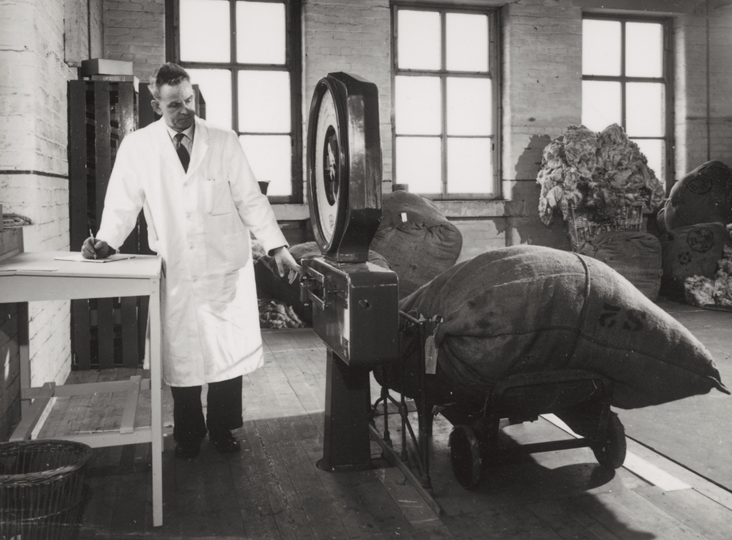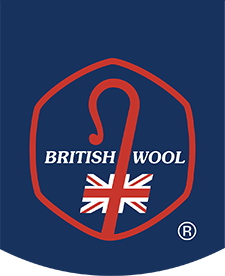The History of British Wool
The introduction of a farmer's co-operative for British wool
The British Wool Marketing Board - now know as British Wool is a public body that was established in 1950 to promote the sale of British wool and provide services to sheep farmers in the UK. Funded by a statutory levy on the sale of greasy wool. It's responsible for collecting and grading of wool from farmers from across the UK and then sell on behalf of it's members (sheep farmers) to sell within UK's only wool auction on to the textile industry both in the UK and overseas
The Shepherd's Crook Logo
In 1972, the introduction of the British Wool Shepherd's Crook Mark logo allowed a way to promote and indentify British wool manufacturing and products in the textile industry. The logo featured a shepherd's crook and a fleece, and it was designed to be a symbol of the quality and authenticity of British wool.
The Shepherd's Crook Mark campaign was in response to concerns that British wool was being undervalued and underused in the textile industry. The campaign aimed to promote the use of British wool in a wide range of products, from carpets and upholstery to clothing and accessories. Over the years the logo has changed only a handful of times, with the Shepherd's Crook always being the constant.
Today, the Shepherd's Crook Mark logo continues to be used by a wide range of textile manufacturers and retailers. And is increasingly being recognised as a symbol of the quality and authenticity of British wool, and it is an important part of the UK's wool industry heritage.
Wool price guarantee
In 1992, the UK government removed the wool price guarantee that had been in place since 1951. This decision was part of a wider set of reforms to the agricultural sector that aimed to reduce the role of government intervention and increase competition.
Under the previous system, the government had guaranteed a minimum price for British wool, which provided a safety net for sheep farmers in times of low demand or oversupply. However, this system was criticised for distorting the market and providing inefficient incentives for farmers to produce wool regardless of market demand. However, the removal of the wool price guarantee had a significant impact on the wool industry in the UK.
The price of wool became more volatile, with fluctuations in demand and supply leading to sharp changes in price. Many farmers struggled to adjust to the new system, and some were forced out of the wool industry altogether.
The next generation of shearers
In 1999 British Wool hosted its first shearing course. British Wool has been actively involved in teaching the next generation of sheep shearers in the UK. And this is an important part of the board's commitment to promoting the use of British wool and supporting the country's wool industry. Whilst promoting the best industry standards to ensure that the process is stress free for the animal as well as maximising the value of member's wool.
Offering a range of training courses for shearers, including beginner courses for those who have never sheared before, as well as advanced courses for experienced shearers who want to improve their skills. These courses cover a range of topics, including sheep handling, shearing techniques, and health and safety.
Since its launch British Wool now trains on average 800 shearers a year. By investing in the education and training of young people, the board is helping to ensure that the UK's wool industry remains a vital and thriving part of the country's agricultural sector for many years to come.
Synthetic fibres and imported wool
The decline of the UK's wool industry began in the 20th century. Cheap imports from countries such as Australia and New Zealand, combined with changing fashion trends. Led to a decline in demand for British wool. Many textile mills closed, and the industry as a whole suffered.
However, there has been a recent resurgence of interest in wool and woolen textiles in the UK. The rise of sustainable and environmentally friendly fashion has led to renewed interest in natural fibers such as wool. Many designers and manufacturers are now focusing on creating high-quality, ethically sourced woolen products, and the industry is once again beginning to thrive.
The effects of Foot and Mouth
The outbreak of foot and mouth disease in 2001 had a devastating impact on the UK wool industry. Foot and mouth is a highly contagious viral disease that affects cloven-hoofed animals, including sheep. To prevent the spread of the disease, the government ordered the culling of millions of animals, including tens of thousands of sheep, lowered Britain's annual wool clip by almost 20%.
UK wool auction enters a new age
The first wool auctions were held in London in the 13th century. The rise of the British Wool in the mid-20th century also had a significant impact on the wool auction industry, with the board playing a central role in regulating the sale of wool.
The role of British Wool has always been to provide an organised structure that manages the supply and demand from the international textile industry. To achieve the best price for the British wool clip to the member. This is a function for which it is widely praised across the world, as most countries have no system in place and achieve far less for their comparative wool than in the UK.
In 2003 the first electronic auction was held and in 2020 the UK was the first country in the world to go remote online auctioning due to the pandemic. An average sale will currently offer about 1.5 million kilos of British wool.
Modern day marketing
The other key role is to promote British wool and ensure that it has a valued reputation with manufacturers, retailers and consumers so they understand the many unique properties of wool. This also helps to ensure the ‘added-value’ of the fibre is upheld in order to maintain prices at sale.
Marketing and promotion now has to penetrate the global textile community – particularly important now that so much manufacturing is done overseas.
The significant expertise within its team is vital to the textile industry and exhibiting at trade shows to advise about wool and discuss individual requirements.
In the past decade, the British Wool has faced a number of challenges, including competition from cheaper wool imports, changing fashion trends, market closures due to the pandemic and now a cost of living crisis. However, the board has responded by diversifying and investing in product development, to increae the demand and ulistiity of British wool into new products and approaching companies to choose British wool. These including developing new markets for British wool in areas such as insulation and wool bedding.
The future of the UK wool industry
As we look to the future of the UK wool industry, these are a couple trends and challenges that face the UK wool industry in the coming years.
One potential trend is the continued shift towards sustainable and eco-friendly products. Consumers are becoming more aware of the environmental impact of their purchases. Leading to an increased demand for wool products that are produced using sustainable and ethical practices. This could include the use of organic wool, as well as greater transparency in the supply chain.
Which is why in 2022, British Wool invested in creating a fully traceable operation to record from farm to the end use and by the end of 2023 all wool graded by British Wool will be traceable back to farm helping to enhance the quality of our fibre and higher return to farmers.
However, the wool industry is also likely to face a number of challenges. One of the biggest challenges is the ongoing impact of the COVID-19 pandemic, which has disrupted global supply chains and caused economic uncertainty and lead to the current cost of living crisis. This could lead to a decline in demand for wool products, as well as increased competition from cheaper imports.
By adapting to changing consumer preferences and leveraging new technologies, the industry can continue to thrive and play an important role in the country's agricultural sector.
Back to Blogs
 Timeline of British Wool
Timeline of British Wool